Bass Fishing Points | Fishing Points For Bass
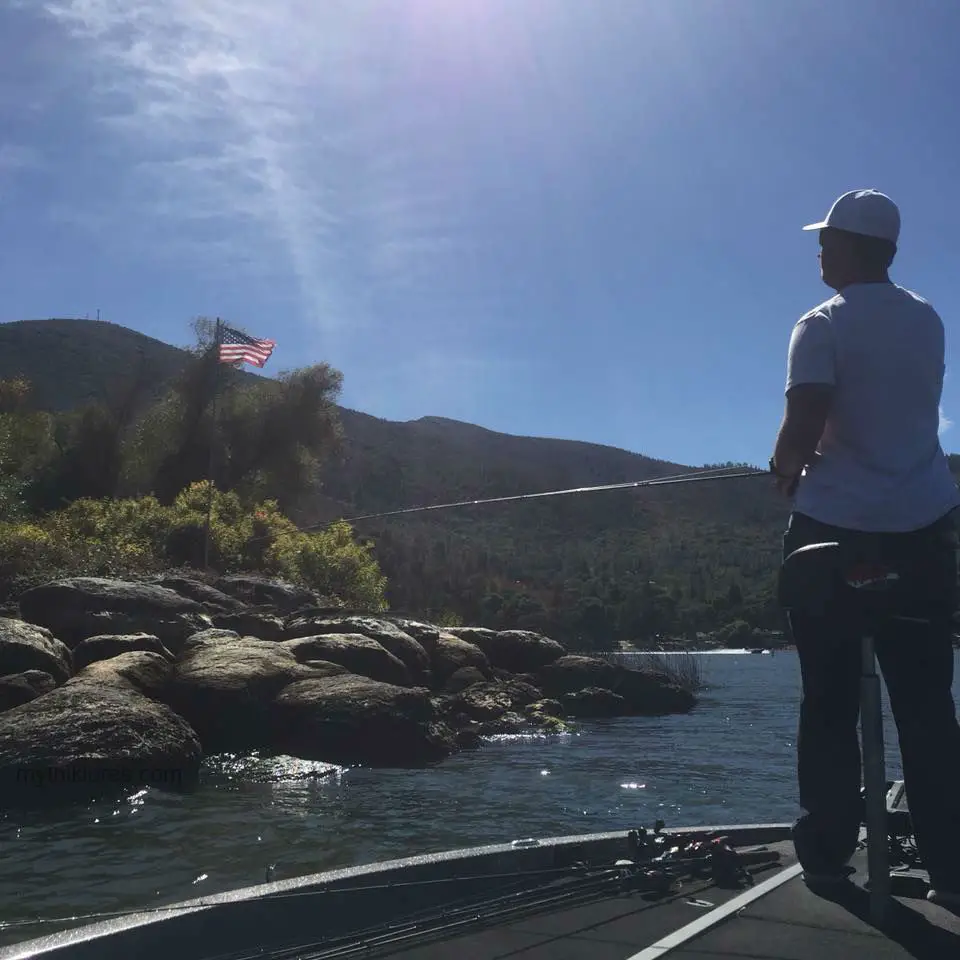
One thing is certain: not all points are made the same.
The key to bass fishing points are: (1) looking for certain sorts of points that have a greater likelihood to hold fish; (2) knowing when to fish certain points throughout the year; and (3) understanding what baits work best.
Occasionally, if you visit any large lake you’ll see tons of points… and… choosing where to start is overwhelming! And to make matters worse, most of the points you’ll encounter may have the occasional fish near them, but the majority will have no fish at all.
To be blunt with you there are only two ways to become successful with fishing points.
The old way is to spend hundreds (if not thousands) of hours on the lake fishing and scanning every single point. But… for the majority of us we don’t have the time or the money to waste, right?
The new way is to fish the points in a surgical systematic way that can instantly give you the green light to start fishing and catching bass!
Now take a second to think about this… Can you imagine yourself having the confidence to pull up to any point and instantly know whether it can be fished or not? Can you see how many more fish you can catch in one day just knowing that? Wouldn’t that be awesome?
Heck yes it would! Listen, If you ever got suckered into fishing at the wrong point, you know it can be similar to being in a barren ghost town, wasting hours of your day, or forced to deal with a painful arm, or worse!
In our fishing blueprint, we’re going to help you avoid all that… let’s get started…
Key Takeaways
Thankfully, bass fishing has become second nature to me now… but that wasn’t always the case. As I spent thousands of hours watching and learning from my mentors, practicing hundreds of hours on the lake… only to fail horribly…
However, over years of honing my skill whenever I had the chance, I slowly started to create my personal point fishing blueprint for beginners, which is kinda-like my private set of strategies and tactics. Now whenever I get to the lake and see points, I use my same blueprint and I can quickly pick out the best points that are most likely to hold fish… which allows me to avoid wasting hours of my fishing day. .. would you like to know more? Yes! Great, here are just some of the things you’ll learn in this point fishing blueprint:
- Understand what point types are more likely to hold fish… and… which to avoid as fast as humanly possible!
- How your PC can get you extra bites when you’re on the water!
- How you can legally check to see if the point attracts bass… even if the dock looks like the hundreds of other points in the area… you will get your answer in less than 1 minute… and helps you avoid spending countless hours on the wrong fishing spot!
- The single best way fish a point… this strategy will allow you to catch all the fish… never worry about spooking the rest… even if fish jumps off your hook!
- Learn the best one-two punch for making bass bite when your fishing points – even Mike Tyson would be proud!
But be warned! Go through this blueprint slowly and carefully so you don’t miss any tips that could cost you.
Point Fishing Primer
If you already know why points are important to fishermen just skip to the next section below, but if you don’t keep reading…
I’m sure you have heard the saying… points point to the fish. Fishing points for bass is one of the oldest ways of catching bass, and has been used by many generations of anglers to catch smallmouth, spotted, and largemouth bass.
Unfortunately, thousands of anglers have tried fishing points, only to move to a completely different type of spot.
Why? Because fishing a point the right way is a closely guarded secret.
Points are the main structures in lakes, sometimes visible from the water or on a contour map. They protrude out into the main lake like a finger or thumb and are magnets for bass and their prey.
Anglers can use any lure or technique when fishing a point, which makes them popular places to fish bass. Points can provide cover for bass because of rock piles, thick grass, weed piles, or lay downs near their locations.
Helpful Tip: Points are also feeding spots for bass since shad and other prey fish sometimes stay in the shallow water near the shoreline at points. Bass follow their prey, so points are excellent hunting and feeding spots for them.
Points are also resting points for bass as they travel around the lake.
Main lake points are points that extend directly into the main lake and are great in early spring, mid-summer, late fall and winter.
Secondary points are smaller points in the creeks or smaller arms of the lake and are great for mid-to-late spring, early to middle fall.
Step 1: What Are the Different Types of Points and Why Are They Important?
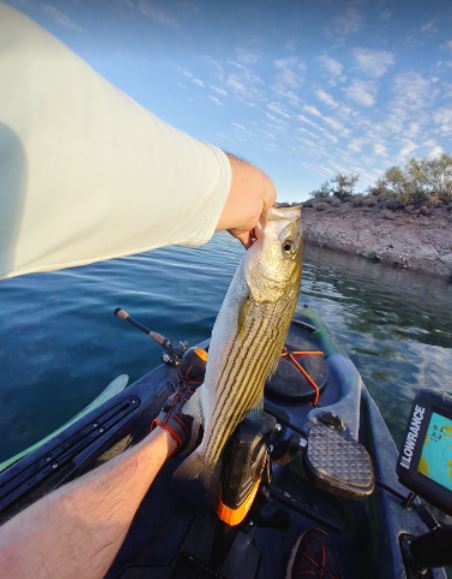
Main lake points are the areas of the shore that extend into the lake. They have slopes on both sides and a rounded top.
Another type of point is the secondary point in coves and bays that look like a finger. Using a topo map or fish finder will help you find out if a point is near deeper water, and that is an advantage.
Secondary channels with points often have bass. They are especially important in the spring during pre-spawn and post-spawn seasons.
Helpful Tip: Bass are moving along areas in the lake to reach coves where they will spawn. Lakes have a “highway” system, and creek channels are their roads.
Secondary creeks provide connections to other areas in the lake, including points on the main lake.
Points are magnets for bass because they have docks, walkways, rock piles, and weed piles where the fish can stay. They are year-round hiding places for bass waiting to attack shad and other prey such as bluegill.
Points are one of the main spots to catch bass. Fish can be hooked into on main lake points or secondary points, but secondary points are often better due to the spawning habits of bass.
Step 2: Finding Quality Points at Home First
One of the best ways for anglers to find potential quality points is with Google Maps. This website can show you a birds eye view of all the points on your lake.
Here are what I consider the 3 prime point locations for beginners to fish… please note… there are more locations to learn, but I don’t want you to be overwhelmed. With that being said, if you’re going to be bass fishing points for bass, these have a better than average chance of holding bass. And they’re going to be:
- (A) Main lake points near deep water
- (B) Secondary points near channel swings
- (C) Windblown points
It’s really easy finding points on Google Maps.
- Simply, pull up Google Maps and start looking at your favorite areas on the lake.
- Next, zoom in and inspect the point.
- Then find the prime point locations that we previously discussed.
- As you find quality points, save the GPS coordinates and plug it into your fish finder for you to use later.

In this example, Step 1 – Pull up Google Maps and start looking at your favorite areas on the lake.

Step 2 – Zoom in and inspect the point. For this example we are looking for secondary points near channel swings…
Step 3 – Find the prime point locations that we previously discussed.
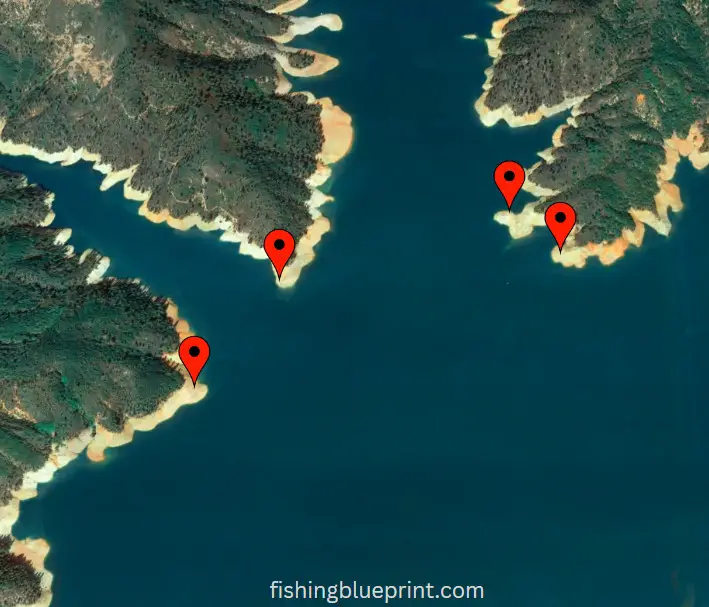
(A) Main lake points near deep water
Main lake points that have deep water near the edge of the point typically have a channel that runs up to or beside the point… this creates a deep water drop off. If the bass wants to flee or feed, main lake points provide bass with a route to get to deeper water.
Additionally, look for this type of main lake points with other types of secondary structure such as rock piles, stumps or brush piles to provide bass with ambush spots in their natural habitat.
Forage fish is the most crucial component that must be present in order for a main lake point to have bass on it.
In general, the summer or winter months are when main lake points house the most fish.
Depending on whether they are eating or resting, the fish will hold there, going into and out of deeper water. During the summer or winter, bass favor spots with more abrupt drops and ledges. The fish may move more vertically thanks to this without having to travel very far.
In the summer, you’ll see bass frequently depart from a main lake point and suspend over deep water because of the presence of a thermocline.
The bass will stay just above the thermocline, which is about 15-40 feet (depending on the depth of your lake), and migrate up onto the point to eat. Rarely do the bass swim below the thermocline.
Helpful Tip: Forage fish is the most crucial component that must be present in order for a main lake point to have bass on it.
In shallow water, shad are much easier to corral and catch. Surprisingly, they use the point’s steep side to ball off the shad school and gobble them up.
When you see bass chasing after shad aggressively over points you can catch your limit under 30 minutes, just a s long as there are no significant weather changes, the fish will concentrate here and the pattern can be fairly consistent.

(B) Secondary points near channel swings
Bass will also relate secondary points, although more commonly in the fall in the fall and spring.
In the spring, bass begin to migrate into the coves to spawn. They have a tendency to stage on secondary points near channel swings during the pre-spawning or spawning phase.
Helpful Tip: Let me be clear, you can catch some GIANT staging bass in this type of point. Here, huge bags of bass can be caught, competitions are won, and massive checks are handed out to the victors.
In the fall, the shad will chase down the remaining pockets of zooplankton in the back of smaller creeks and coves… and the bass instinctively follow.
These secondary points and coves turn into bass feeding frenzy areas. Search for secondary points that are near a channel swing or extend directly into a channel will give you the best chances for success.
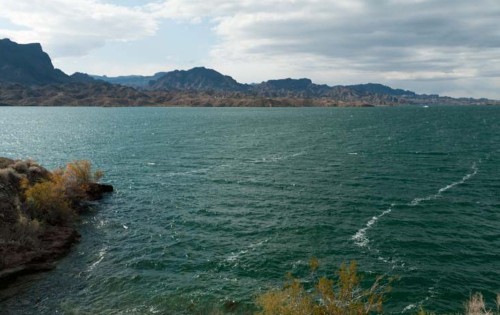
(C) Windblown points
Don’t shy away in a safe cove the next time you experience strong wind when fishing. When it comes to bass fishing on windblown points, the wind is unquestionably your best friend.
Bass can be found in relatively predictable locations, particularly more so when they are near windy points.
Extremely aggressive feeding activity can be triggered by the wind pushing the bait up against the point’s steep banks or ledges. This also stirs up the water and increases its oxygen level further increasing the feeding frenzy… it’s kinda like adding gasoline to a dumpster fire
It’s not uncommon for you to motor across the bay to a windy point and catch 20 fish on a single spot, after fishing calm points all day for one to two bites.
Helpful Tip: The best anglers view the wind as an enormous beacon for anglers to come and fish it.
Lucky for you, the lure’s profile will be broken up when the wind churns the water and kicks up sediment. On the other hand, in calmer conditions they are far more likely to spot your hooks, line, or split rings.
Even better, you don’t have to be quiet when you’re fishing in windy conditions.
So when you choose your windy point try to make as long a cast as you can into the wind (called cross casting). It gives you the best opportunity for bass to see and eat your bait. Even though it could be annoying at times, staying with it will have huge benefits.
When casting with the wind against your back, yes it’s easier to cast, but you’re likely delivering your lure from behind the fish, giving them a very little window of opportunity to detect and eat it.
Helpful Tip: Wind creates current, and bass face up-current whenever feasible.
Those bass will be able to see your bait approaching and have a lot more time to respond to it and track it down if you can throw against the wind.
Other things to look for on the point…
- Knowing that bass like to hold in an area on a point with a deeper creek channel near shallow water, you can skip fishing points that do not have this feature.
- Next, look at the shoreline on your map for irregularities such as fallen trees, large rocks or rockslides, or other mini points. If you find points with all three characteristics such as being close to deeper water, having cover, and having irregularities, then you have found the best spot to hook into bass.
- Some bass do not move into deeper water but stay on points all year long.
Step 3: Identify the Point With Your Fish Finder/ Sonar and Scan It
Now that you are on the water it’s time to confirm the quality of the point you are fishing.
Step 1) I strongly suggest starting with a side scan first over the deepest section of the tip.
Then if you see anything such as a piece of secondary structure (such as a rock pile or brush pile), or if you scan to detect a school of shad or bass, then I would move on the step 2.
Step 2) After you side scan the point, start from the deepest area and drive straight across it. Going back and forth in a zigzag pattern until you get shallow.
Scanning the shallow sections can be a little difficult, but with a little practice scanning the point is easy to do.
Below is an example of a point you want to fish.
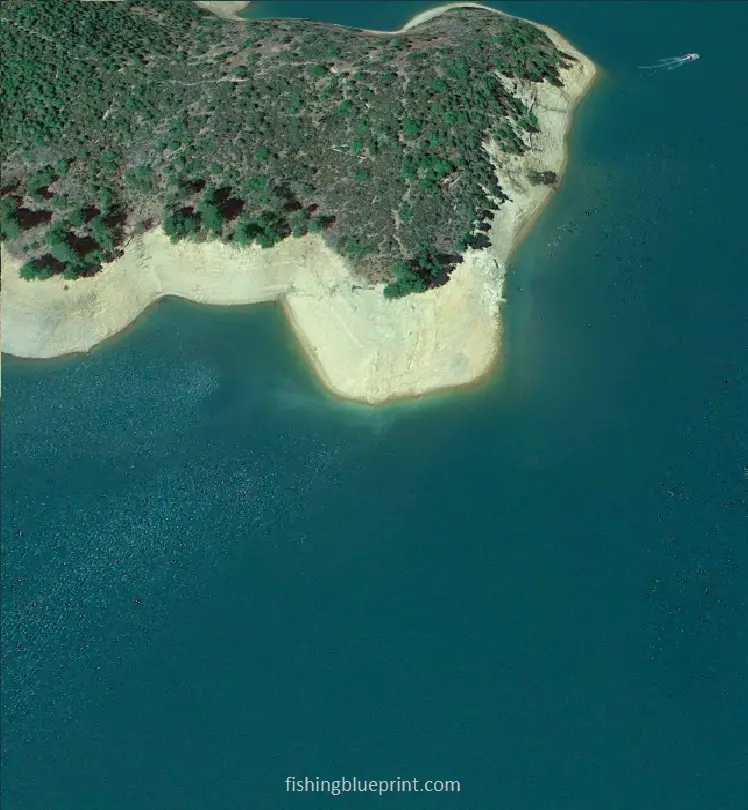
Now you did your homework and researched this point and can see what this point looks like when the water is really low… Look there, a big rocky ridge near a creek channel!

So you get to the lake. Step 1 start side scanning the area…
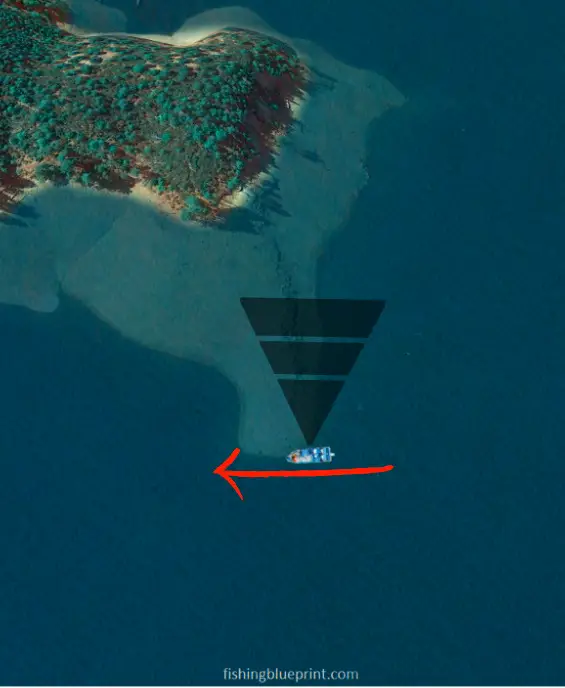
This is what it should look like with your side scan sonar (image below).
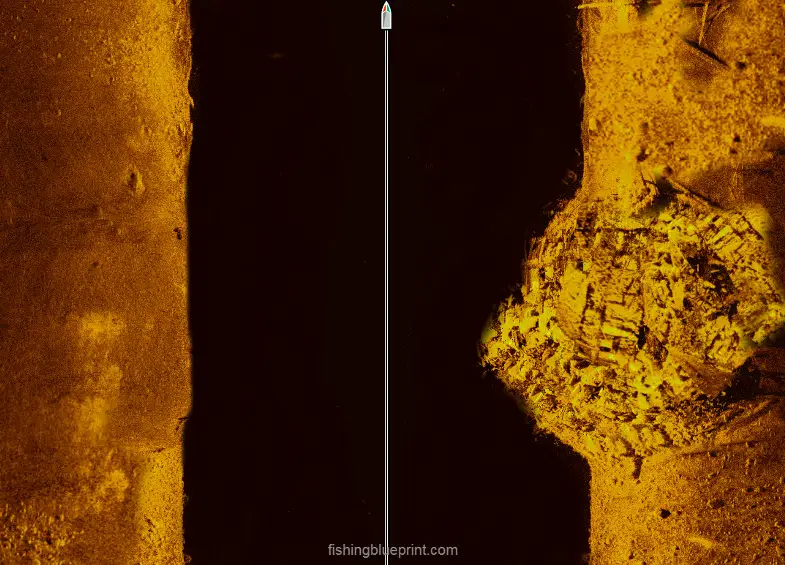
This equipment will also check the depth of water, water temperature, speed, and heading as you drive your boat over the lake.
If you see balls of bait you and the area looks like a good spot, then switch to you structure scan and 2D sonar
Start by driving back and forth cutting directly across the point.
As you drive up and over the point, the top of the bump will signify the top of the point and will gradually get deeper.
It will look like an inverted-V on your electronics.
Lastly, take note if there are any bass that are related to the point.
Bass will appear as arcs with spaces between each one on a fish finder. They are usually in a horizontal line and do not pile up more than two or three fish above another one.
Finding Active vs. Inactive Fish
When scanning a point you want to see the bass on the top. This signifies the bass are actively feeding. These fish are extremely catchable anytime they are relating directly on top of point, best of all you can typically catch them using an assortment of lures.
Look at the images below. This is a downward scan image I recreated to show you what bass look like when they’re relating to the apex of the point, they are the large arcs. The smaller dots represent baitfish like shad.

The bass will suspend above the deeper water, off to the side of the point are not actively feeding. As an illustration in the picture below, they are off to the side of the point.
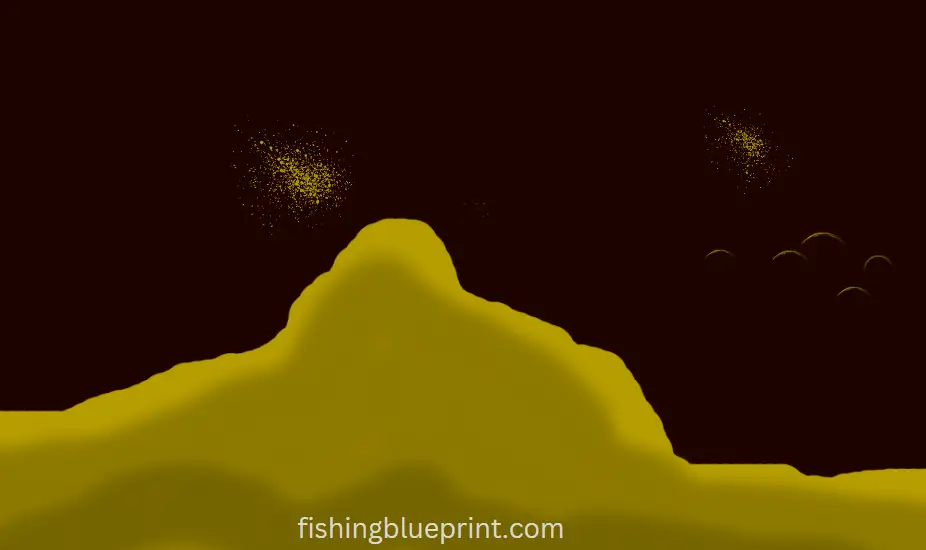
Step 4: Fishing The Point Systematically
Experienced anglers say that the best strategy to fish a point for bass is to fish the sides of the point first. Whereas, many other anglers say to fish across the top of the point and then work your way around the perimeter of the point.
What’s cool about fishing a dock is you can actually fish it in five different ways.
Personally, I recommend fish across the top of the point first approach.
- If it’s breezy out I will position the boat facing the wind. Many times bass will position themselves facing into the wind, especially on wind blown points. The wind will create a current and will blow small schools of minnows and baitfish across the point. So naturally, the bass will face into the current ready to gobble up any unsuspecting shad.
- If it’s early in the morning and calm I will try to cast into the sun, I don’t want my shadow to give away that I’m there, especially if the water is clear. Yeah, I know it sucks, but just buy a pair of good polarized sunglasses and you’ll be fine.
- If it’s nighttime or cloudy I’ll position the boat with the wind against my back. I’m not worried the bass will see me, and casting with the wind gives me extra distance.
- Second, start working your casts from deep to shallow.
- Third, fish the sides.
- Lastly, you can position your boat in shallow water and cast into deeper water. A lot of time bass will chase schools of shad into shallow water and will prefer this presentation.
What are the Best Baits For Bass Fishing Points?
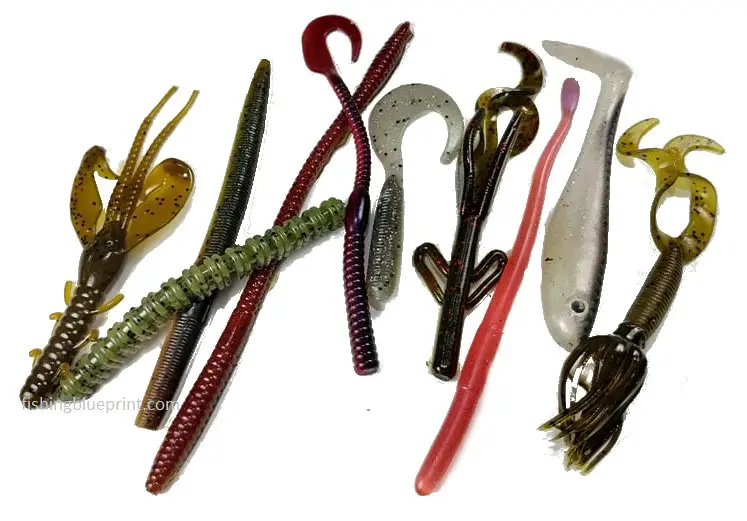
When choosing what bait you should you here’s a quick and easy list that helps me:
- Topwater lures, buzzbaits in the morning or on cloudy conditions.
- Crankbaits, spinnerbaits, jerkbaits, chatterbaits, umbrella rigs, underspin jigs, swim jigs, hair jigs, lipless crankbaits, and soft plastic swimbaits, perform well here in breezy conditions or during the midday.
- In contrast, slower moving baits such as drop shot, football jigs, tubes, wacky rig, Texas rig, Neko rigs, and Carolina rigs can be phenomenal when the conditions are calm or the bass are holding close to the rocks.
- Flutter spoons work great in the deepest part of the dock or over any secondary structures directly related to the dock.
Fishing Main Lake Points Vs Secondary Points
In the winter time bass will prefer to hold in main lake points in deeper water because those areas are less susceptible to dramatic weather changes.
Bass choose locations that are steep, near deeper water, or that have some kind of vertical or steep structure. It is easier for bass to swim vertically to feed and then descend into more stable water since the water is frigid and the bass, who are cold blooded, do not like to chase after shad.
Many bass will linger in deep water throughout the summer because it gives them the best chance to target shad.
In the spring and the fall, you’ll discover that secondary points perform far better than the major lake points.
Bass fish like secondary points in the spring because they are traveling into the back to spawn.
And in the fall bass will be chasing shad who are eating up the last pockets of plankton in the coves and arms off of the main lake.
Best Time of the Day to Fish a Point
The best time of the day to fish a point is up to two hours after sunrise and two hours before sunset. Bass do not like bright light because they prefer to hunt for prey in stained water or muddy water.
Bass are more active and aggressive in dim light. They have good eyesight and need light to hunt, but bass tend to avoid bright light.
Serious anglers often think that the best time to fish bass is late afternoon. Late afternoon might be two hours before dusk in the late fall, winter, and early spring.
Early morning is the next preferred time for fishing bass. Bass prefer this time, and they also become more active and aggressive in the dim hours as the sun rises.
There is disagreement about the best time to fish bass. Experts contend that you can hook onto bass any time of the day if you know how time and weather affect fishing bass on points.
My Personal Notes: My 2 Biggest Problems with Fishing a Point
One of the biggest problems I personally had with fishing points is finding where bass are located. Not all points house bass and finding points that do have bass hiding under docks or other cover on them can be challenging.
In the beginning I spent hundreds of hours there and never hooked into any bass. While it was nice to get on the water, it really wanted to catch a lunker. I tried nearly every technique and every lure in my tackle box and still did not have any bites.
That was until I started really honing why curtain points worked better than others. It was then I started to notice a pattern why some points are better than others. Hence why I exposed the 3 best points to find and fish when you’re just beginning.
Furthermore, I also discussed when to fish main lake points versus secondary points and why.
Helpful Tip: Following this blueprint will increase the numbers of bass you hook into.
Another frustration that I had was I was not throwing the right type of bait at the right situation. I tried nearly every technique and every lure in my tackle box and still did not have any bites.
I turned to online articles and videos featuring professional anglers having several rods and many types of new baits and lures, not realizing they were supplied by their sponsor for advertising their products.
Needless to say unbeknownst to me, I would go out and buy that product thinking it’s going to catch me a giant bass, only to find out it’s no better than the lures I already had.
I came to realize I lacked experience. It’s not like I needed a specific brand of bait, but I just didn’t recognize that I should have been fishing one style of bait over another.
It was then I sat down and created a list of the best performing baits for fishing points and most importantly – when to fish them.
Then I put all of my thoughts down on paper and created my blueprint for fishing points.
After I did that it was like putting the icing on the cake. The completed blueprint functioned as a complete system and allowed me to become proficient at fishing points ever since.
Want To Learn Where To Catch More Bass? Checkout These Articles...
- Bass Fishing CREEKS The Easy Way (In Less Than 10 Minutes)
- Warning: Bass Fishing HEAVY GRASS? [15+ Mistakes To Avoid]
- Bass Fishing POINTS in 5 Quick & EASY Steps!
- Complete 5-Step DOCK Fishing Formula
- Bass Fishing LAYDOWNS [Complete Guide + Pictures]
- Little Known Pattern for Fishing TREES for Bass.. Now and Forever
- Complete Formula For BASS FISHING ROCKY BANKS & RIPRAP
- The 5 TRUTHS about Bass Fishing BRIDGES and Avoid Wasting Time On Techniques That Don’t Work!
- Bass Fishing BRUSH PILES To Catch The Most Bass In Minimum Time!
- The 7-step Secret Formula for Bass Fishing LEDGES – Even a Complete Fishing Noob Can Use and Be 100 Times More Potent Than the Best B.A.S.S. Professional!
- The Single Best Guide to Fishing SHELL BEDS… and… Do It Fast!
- 5 Basic Elements Of Fishing HUMPS AND RIDGES No One is Talking About!
- 5 Crucial (and Unusual) Tactics You Must Do When Bass Fishing ROADBEDS!
- Top 25 Summer BANK Fishing Tips (Never Get Skunked Again)
- [EXPERT REVEALS] Bass Fishing In MUDDY WATER Secrets – 27 Tips & Mistakes To Avoid Today!
- 31 Best Tips for Bass Fishing At NIGHT (Complete Guide)
Checkout These Other Summer Fishing Articles...
- Complete 5-Step Formula For BASS FISHING DOCKS
- The 7-step Secret Formula for BASS FISHING LEDGES – Even a Complete Fishing Noob Can Use and Be 100 Times More Potent Than the Best B.A.S.S. Professional!
- Top 25 Summer Bank Fishing Tips (Never Get Skunked Again)
- Bass Fishing In Heavy Grass? [17+ Mistakes To Avoid]
- 7 Top Secret Weedless Bass Lures for Flipping into Heavy Grass -Exposed!
- How To Fish A Crankbait [TOP 10 Essential Secrets To Catching Bass With A Crankbait]
- 15 Best Deep Diving Crankbaits [2023 Buyers Guide – Which to Buy & Avoid]
- Fish a Flutter Spoon The RIGHT way... like the Pros... And Do It TODAY!
- NEW and truly "no brainer" (yet usually overlooked) way to MASTER SOFT PLASTIC PADDLE TAIL SWIMBAITS and increase the amount of bass you catch 100% or more... automatically!
- Top 5 questions and challenges every about hair jig fishing... AND how to overcome common problems most anglers encounter (and then prematurely quit).
- Top 10 Best Jigs For Bass Fishing [Insiders Only]
- Avoid this ONE Texas rig fishing NIGHTMARE - And increase your Texas rig fishing expertise FAST!
- 31 Best Tips for Bass Fishing At NIGHT (Complete Guide)
- 2023 Buyers Guide Best GREEN FISHING LIGHT [LED FISHING LIGHTS Reviews & Tips]
- Dock Lights For Night Fishing [Best Products, Secrets, & Tips]
Other Bass Fishing Articles Just For You...
Funny Fishing Rules, Laws, and Regulations 2025
Crazy Fishing Laws That Will Blow Your Mind! #7 is INSANE! Strange Fishing Regulations and Laws As silly as hook and rod limits may seem,
EXPOSED! How To Use A Spinnerbait The Right Way for 2025
Are You Wondering How To Use A Spinnerbait? Or How To Work A Spinnerbait Over Grass, Logs, or Points? Well, All These Questions Are Answered
EXPOSED! Best Crankbait Colors for 2025 [Which to Buy & Avoid]
What color crankbait to use? Crankbait Color Chart I just love going into a Bass Pro Shops store and just staring at all the walls
Best Underwater Dock Lights For Fishing – 2025 Buyers Guide
Night Dock Light Fishing For Beginners Dear fellow angler, Does this sound like you? You’re someone who loves fishing but just wants to escape the
15 Best Deep Diving Crankbaits [2025 Buyers Guide – Which to Buy & Avoid]
A Complete Buyer’s Blueprint On The Best Deep Diving Crankbaits for Bass, Walleye, or Striped Bass On The Market Today Fishing deep diving crankbaits can
